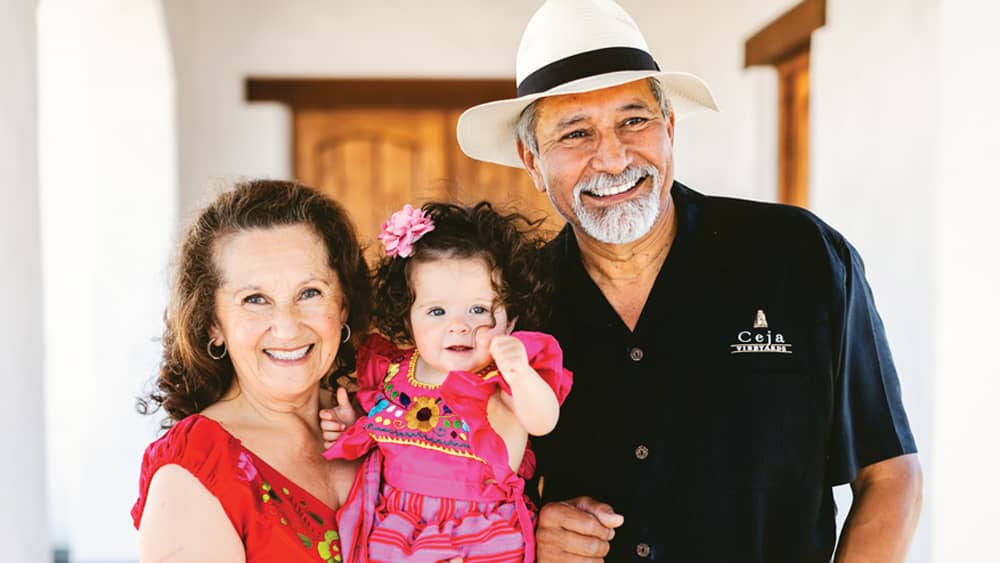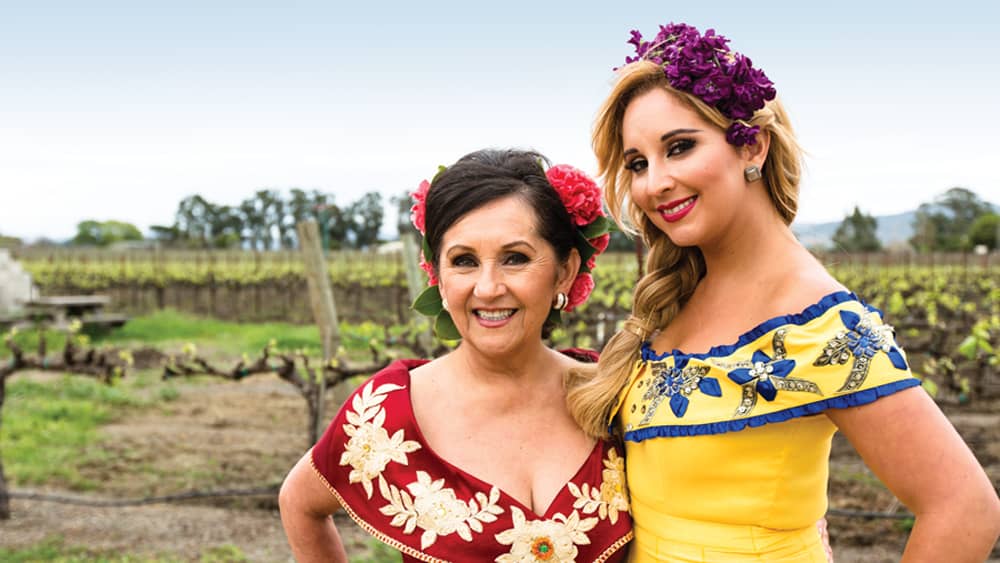
Amelia Morán arrived in Rutherford, Calif., with her family in the early evening hours of September 11, 1967. An immigrant from Mexico, 12-year-old Amelia brought far more than her material belongings and green card. Within her heart, she held her grandmother’s tenacious spirit. And, deeply rooted within the confines of her soul was her passion for food, family, and beautiful Latin heritage.
Soon after their arrival, a friend of Amelia’s father, Pablo Ceja, also emigrated to the area from Michoacán, Mexico. Pablo and his family resided in a barn for a short time, and Amelia’s father, Felipe, offered Ceja and his sons, Pedro, Armando and Ignacio, a job harvesting grapes. “We started harvesting grapes together in Oakville, and my father showed us how to cut the grape clusters safely off the vines,” Amelia recalls. “He assigned us a number and every time we filled the buckets with grapes and dumped them into the grape hauler, we called out our assigned number.” Pedro, also age 12, helped Amelia get her grapes into the bin. “Pedro helped me with the bucket because I could not reach the top of the grape hauler. And he helped me the entire time we picked grapes together.”
Then one day, while picking Merlot grapes at To Kalon, near Robert Mondavi’s vineyard, Amelia said to her father, “Voy a tener mi propio viñedo algún día.” (I will own my own vineyard someday). And to that, her father replied, “Yes, you will.”
The two seemingly random events during those early days in Napa Valley offered a glimpse of young Amelia’s future.
Humble beginnings
Felipe Morán chose not to be part of the popular Bracero program and charted his solitary path. (The Bracero program was an agreement between the United States and Mexico that gave jobs to immigrant workers, mainly in Texas and California. It was initiated in 1942 to eradicate the workforce shortage due to World War II but was terminated in 1964.) Hard-working and ethical with a mechanical mind, Felipe knew he could be successful.

In June of 1967, Amelia finished sixth grade in Los Flores, Jalisco. It was the same day she learned she would become a resident of the United States. “There was excitement in our kitchen as we opened a letter from my father,” says Amelia. “He had applied for confirmation for us to get our Mexican passports from the Consulate in Mexico City.” Amelia’s visit that summer to the Mexican Consulate opened her eyes to the world. “I had never been to a big city. Seeing the pyramids at Teotihuacan changed my life as I thought about my roots from the ancient cultures of Mexico. I not only came from an amazing matriarchal family, I now understood my heritage. For me, it was compelling.”
Amelia’s father left this car in Mexicali, Baja California, at an aunt’s house when he met his wife and two girls in Guadalajara, Jalisco. They all traveled north together by train and stayed a couple of days in Mexicali. Then, finally, they crossed the border in his Ford automobile on September 11.
A chance for success
Amelia began school as a seventh-grader at Robert Louis Stevenson Middle School in St. Helena. “We arrived in Rutherford early in the evening on Sept. 11 and went directly to the location where I had to take the bus to school early the next morning,” she recalls. Her father had previously enrolled her, figured out the bus schedule, and bought her school supplies. She was placed in a special needs program since she did not speak English.
Amelia’s father and mother dedicated their lives to giving their children a chance for success. Though they could not help academically, they would stay up with Amelia late at night while she studied, providing her moral support, hot tea and nourishment.
An infinite number of situations she encountered as an immigrant gave Amelia the impetus to succeed. Very few immigrant children attended public schools. “At the time, it was mostly men that came to harvest the grapes, and they didn’t bring their families,” she says.
Amelia felt isolated, but she had a dream of owning a vineyard, and she knew she would face many challenges in the male-dominated wine industry. And though she was quite young, she recognized the importance of getting an education. “Nobody can take your education away from you. It is yours. It gives one such a sense of confidence,” she says. “We can change our own life’s journey through education.
Young Amelia focused on her studies and by the end of the school year, she was fluent in English and won multiple academic awards for her achievements.
Though she excelled academically, she was underwhelmed by the school’s food program.“I did not like the lunches they served at the school since I was so used to my authentic Mexican food,” she recalls. “So, I brought my lunch from home. The other students would gather around curiously to smell the beautiful aromas emanating from the soups my mother would prepare for me.”
Because her family wanted her to have a solid Latin background that enhanced her American education, Amelia returned to Mexico for two years to attend high school in a large city. An exclusive boarding school with steep tuition would not deter her parents from advancing Amelia’s education. “My family wished for me to know more of our culture and to explore Mexico,” she says. “That’s why I went back to Mexico.”

“Service-learning was mandatory at this school, so I chose to volunteer in the kitchen. I had the background and a passion for cooking because I had served as my grandmother’s sous chef all my life. Unfortunately, I had to get up at 5:30 a.m. to do my service, and my friends thought I was crazy. They tried to talk me into tutoring others in science and math instead. But no. I wanted to cook.”
The school’s kitchen was state-of-the-art. Parents who owned pineapple orchards and meatpacking plants donated crates of food and gourmet cheeses. “My passion for Mexican cuisine intensified. I got another education in authentic Mexican cooking!” After two years in Mexico, Amelia returned to the Napa Valley and graduated from Justin Sienna High School. She had already completed the prerequisites for graduation from high school, which allowed her to attend Napa Valley College in the afternoons. Upon graduation, she had earned nearly two years of college credit.
After going their separate ways in high school, Pedro Ceja finished his college degree in electrical engineering. Amelia graduated from the University of California, San Diego, with a degree in history and literature. Pedro’s little brother, Armando, became a winemaker after earning his enology degree from UC Davis in 1985.
Amelia’s passion for cooking came full circle while living in the dorm at U.C. San Diego. Once again, Amelia hated the cafeteria food, so she made her own. “Initially, I cooked for myself in a kitchen shared with the entire floor. And later, as the aromas wafted from the kitchen, my roommates wanted to eat what I was eating. I started with taking up a collection from students who wanted to partake. A couple of bucks here and there, and we would cook a meal and eat it together. I became the executive chef; my friends served as sous chefs. We would go to La Jolla on the bus and go shopping once a week. On a Friday or Saturday night, we would cook, and we had good wine. I fell in love with grape growing and the love of food.”
Synchronicity
Amelia and Pedro Ceja crossed paths one summer evening in June. She was outside getting into her little red Fiat to go to work at the Grapevine Inn (now Brix Restaurant) in Oakville. “I spotted three, tall handsome young men in running shorts, jogging down Highway 29, so I waited for them,” Amelia recalls. As they approached, she recognized them. The three men—Pedro, Ignacio and Armando Ceja—were training for a marathon. They worked in a vineyard in Oakville and would jog home to St. Helena after work. They invited her to a party, but Amelia had to complete her shift. “If you get bored at the party, come over to the restaurant,” she quipped. Later that evening, Pedro walked into the Grapevine Inn, changing the course of their lives forever. They married in 1980.
They spent the first five years of their marriage in Silicon Valley. Pedro worked as an engineer to support his young and growing family. Although they knew finances were tight, the young Ceja family drove through the Napa countryside dreaming of buying vineyard land on weekends. They had the insatiable desire to grow grapes. In 1983, the Ceja brothers, their parents (Pablo and Juanita), and Amelia pooled their resources and purchased 15 acres in the Carneros region. With no business plan and saddled with what Amelia calls “jumbo loan” payments, they moved back to Napa in 1985, living in a one-room studio that was attached to a ranch house where the entire Ceja family lived. During that time, Pedro made the 90-mile commute to and from work in Silicon Valley during the week.
Somehow, even with 17% interest rates, they were able to persevere and begin their life’s dream as vineyard owners.
Armando became a highly respected vineyard manager, never losing sight of the family plan, and 1986 was a triumphant year. Thirteen acres were planted with Pinot Noir grapes, and Armando married the beautiful and spirited Martha Brambila. As the family expanded, little children could be found playing and digging in the vineyards on Ceja land. Armando secured a contract from Domaine Chandon to develop the property.

“They needed much growth for Pinot Noir grapes. When people believe in you, they conspire to help you with your goals,” says Amelia. Chandon told Armando to plant pinot noir grapes, and they would buy them. “So, in ’86, we were able to grow the grapes. We did it on weekends and at night with family and friends with the vine starts we got from Domaine Chandon. We also got a five-year contract,” says Amelia.” Their first harvest was in 1988.
“We made a barrel of wine, and it was fantastic. “We knew how to grow the best grapes because we had so much experience, and we had a winemaker in the family.”
The Ceja family planned to eventually release wine under the Ceja brand, and after purchasing 65 more acres on the Sonoma Coast in 1994, they were ready. Over the years, they raised their families, grew grapes for other wine companies, invested what little profit they made in more land, and finally launched the Ceja Vineyards brand in 2001. Pedro used a church bell as the trademark for their brand since it fit perfectly with their collective dream of building a mission-style winery. The bell includes a Latin inscription, Vinum, Cantus, and Amor, which translates in English to wine, song, and love. Ceja wines are a true reflection of their origins. Sauvignon Blanc, Chardonnay, Pinot Noir, Merlot, Cabernet Sauvignon, Vino de Casa red blends, and dessert wines are planted in Ceja terroirs where they grow best.
Today, Ceja Vineyards sells most of its grapes to other vintners and produces about 5,000 cases of wine each year. Currently, the vineyards are not open to the public, but their premium estate-grown wines can be sampled and purchased at their tasting room on Burndale Road/Highway 12 in Sonoma and online at cejavineyards.com. Construction plans for a winery and tasting room in Carneros are underway.
The next generation
Dalia Ceja, the youngest daughter of Amelia and Pedro, earned a bachelor of arts in marketing and communications in 2008. After a backpacking journey through South America to interact with her ethnic and cultural identity, Dalia jumped in, full throttle, as the marketing and sales director for Ceja Vineyards. With her expertise in social media and an MBA in wine marketing from Sonoma State, she created a successful online presence for the family business.
Like her mother, Dalia has an inherent talent for creating Mexican cuisine with subtle, complex flavors that pair beautifully with Ceja wines. “A lot of minority-owned wineries are developing their own style,” says Dalia. “For us, it’s been about family and taking wine to a new level.”
Amelia and Dalia are also passionate about uplifting and empowering one another in a male-dominated industry, holding each other up, and pursuing higher education as the key to success. It gives people hope.

“Any young girl can change her trajectory in life,” says Amelia. “To other young women struggling and finding their path: It doesn’t matter where you begin; what matters is what you do from that point on. Sometimes you can be stuck in your little world and only see the negative aspects, but we are each responsible for our own story. You cannot blame others. We can write our story ourselves. I never allowed someone to write my story.”
Women have challenges everywhere, no matter what the culture. Until we are equals and meriting a seat at the table, those struggles will continue. “I have dedicated my life to working towards a more just world for everyone,” says Amelia. “My primary focus is women and children. That’s how you change situations. If you empower children, they will be okay their entire lives.”
Since arriving in America 54 years ago, Amelia Ceja built a legacy with her family and made her mark in a male-dominated industry. Today, Amelia is president and CEO of her own company. In addition, the California legislature recognized her as “Woman of the Year” in 2005 for “breaking the glass ceiling in a very competitive business.” Today, she is the first Mexican-American woman ever elected president of a winery in the world.
Though their roots were humble, the strong family Ceja dynamic perpetuated a shared vision, for that symbolic Ceja bell will soon ring at the new tasting room in Carneros, where it all began 38 years ago. The legacy lives on, bringing a new generation of Cejas to the family table. May the wine, song and love continue.
The Food-Wine Connection: Pairing Ceja Wines with Latin-American Cuisine
Amelia Morán Ceja’s’ love affair with flavors began at the age of 8 in the farm kitchen of her strong maternal grandmother, Josefa Fuentes, or Mama Chepa, as Amelia called her, who taught her to cook with fresh, homegrown ingredients and identify edible wild mushrooms by smell. Additionally, traditional Mexican cuisine envelopes an array of chilies, vegetables, meats, and fish native to Mexico and other South American countries. “I am fortunate to have come from a grandmother, who was the matriarch of the village. She was a very headstrong woman and an amazing cook, hence my prolific love and passion for cooking.” Today, Amelia is a Napa County certified master gardener, and is a member of the Master Gardener Program, a volunteer organization with the University of California, Davis, cooperative extension.
Amelia and her daughter, Dalia, have created how-to cooking videos for years. These videos, which feature wine and food pairings, are available for viewing on their website and demonstrate how wine and Mexican food marry. “You see the food on the plate, and your mind goes to the wine that you have tasted with that food for as long as you can remember,” says Amelia.
Dalia shares her mother’s passion for pairing Latin food with wines. In 2009, she brought her expertise to Ceja Vineyards as the marketing and sales director. “A lot of minority wineries are developing their own style,” she says. “For us, it’s been about family and taking wine to a new level.” And for Dalia, being a Ceja means being part of that evolution, which includes promoting awareness of authentic Mexican cuisine and its subtle, complex flavors—the perfect companion for pairings that yield a new wine experience.
For more information and recipes, visit cejavineyards.com. Their recipes are also available on saludnapa.com.
Albóndigas en Salsa Roja: Mexican Meatballs in a Spicy Red Salsa
Serving Size: 6
Cook Time: 2 Hours
Difficulty: Medium
Measurements: Imperial (US)
In Spain and Latin America, meatballs are called albóndigas, derived from the Arabic al-bunduq (meaning hazelnut or a small round object). The Arabs brought a version of this dish to Spain, and it eventually became popular in kitchens in Mexico and Latin America. Mint is often found in Mexican versions, and it adds an intriguing light element to the dish.
Mexican albóndigas are commonly served in a soup with a light broth and vegetables or in a spicy red salsa to fill tacos. Both versions define comfort food, but as the fall equinox begins, the more decadent, spicier recipe pairs well with Ceja Cabernet Sauvignon-inspired red wine blends.
Ingredients
For Red Salsa
8 Roma tomatoes, cut into quarters
3 guajillo peppers, deveined and deseeded
2 jalapeno peppers, cut in half
2 serrano peppers, cut in half
6 garlic cloves
1/2 small onion, cut into two pieces
1/2 onion, medium diced
6 whole cloves
pinch of cumin
pinch of Mexican oregano
salt and pepper to taste
water (beef broth optional)
2 tablespoons olive oil
For Meatballs
2 lbs. ground beef or a favorite combination of pork or lamb
1/2 cup uncooked rice
1/2 cup chopped fresh mint leaves
1/2 small onion, shredded
6 garlic cloves, minced
2 eggs
1 tsp Mexican oregano
1 tbsp. flour
salt and pepper
Directions
For Red Salsa
Place tomatoes, guajillo, jalapeño and serrano peppers, 1/2 onion and garlic cloves in a medium stock pot with enough water (or beef broth) to cover all the ingredients. Bring to a boil and reduce heat and simmer for 10 minutes.
Process all cooked ingredients in a blender with the whole cloves, pinch of cumin and oregano, and salt and pepper to taste until smooth.
Heat a large skillet over medium heat and add 2 tablespoons of olive oil, diced onion and a pinch of salt and pepper. Stir and cook until translucent, about 3 minutes. Add processed salsa ingredients and bring to a boil. Reduce heat and simmer and add more water or beef broth to achieve the preferred consistency.
For Meatballs
Place all the meatball ingredients in a large mixing bowl. Combine the mixture well then, using your hands, form meatballs that are about one-inch wide or slightly larger.
Place the meatballs in the pot with the simmering red salsa and add more water or stock to just cover the meatballs. Bring to a boil again, reduce heat to simmer and cover pot until meatballs are plump and tender, about 30 to 45 minutes. Once the rice in the meatballs is cooked, it increases the size of the original meatball and adds a creamy texture.
Serve albóndigas in a bowl with some of the rich salsa roja and garnish with finely chopped cilantro. Heat corn tortillas and make delicious tacos to pair with a Ceja exceptional red wine blends.
Recipe courtesy of Dalia Ceja



